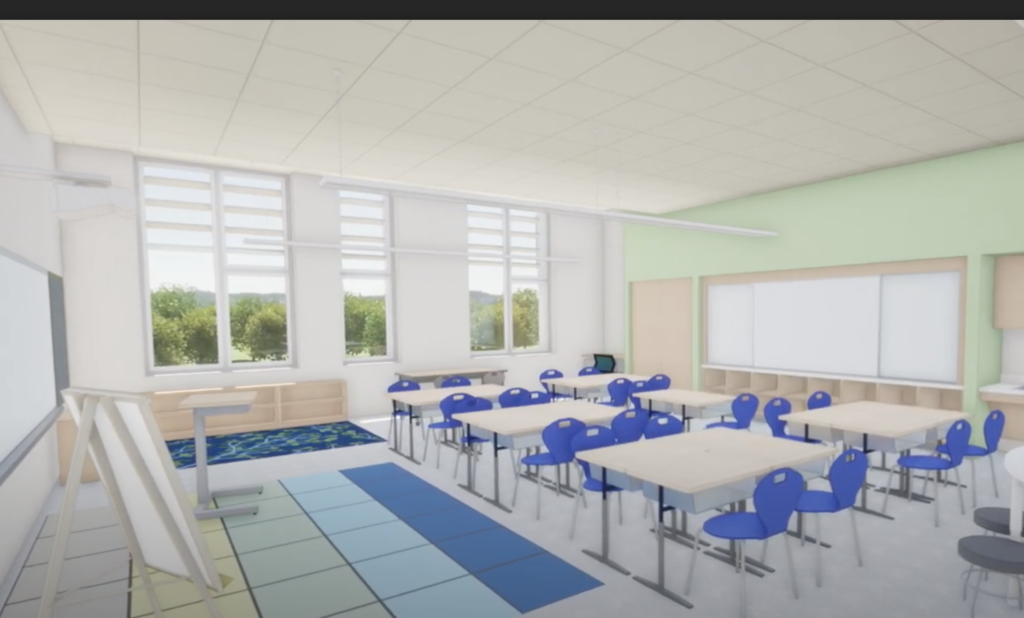Letter: Envisioning Amherst’s New Elementary School

Architect's rendering of a classroom in the proposed new elementary school at Fort River. Photo: DiNisco Design
by Rebecca Fricke and Meg Gage
Classrooms infused with daylight and fresh air, small group learning spaces, a positive learning environment for children of all backgrounds and abilities. This is our vision for the new elementary school building, and we hope you will join us in voting yes on May 2.
Thoughtful educational goals and curriculum requirements guided the design of the building. Indoors and outdoors the design reflects Amherst’s commitment to strong elementary school pedagogy that appreciates, nurtures, and challenges all of our individual students to reach their full potential as learners and global citizens. Classrooms have been carefully arranged on three floors with many opportunities for inter-class and inter-age interactions, small group projects, and individual tutoring and support. Plans include generous spaces for healthy outdoor activity for groups, teams and individuals.
Equally important, it will be Amherst’s first public net zero building with all electric geothermal and solar photovoltaic systems. There will be a utility rebate of $1.6 million for the geothermal system as well as new federal tax credits. With renewable energy offsetting electric use, Amherst will see an annual savings of $250,000 in electric and fuel costs once Fort River and Wildwood are closed. The elementary school will be Amherst’s most significant town-owned step toward climate action to reduce emissions and will be an example for other towns in the state.
We live in a very diverse community, reflected in our multicultural student population, thanks in part to the University and the colleges that employ faculty and graduate students from around the world. Our community is enriched by our children’s new friends from other countries, introducing new foods, different customs and new ways of seeing the world and each other. The new school provides a platform to celebrate our diversity and support our high-quality innovative education. It will make Amherst a place where families want to live and raise their children.
According to the Massachusetts Department of Education’s “Schools and Districts Profiles,” English is not the first language of 26% of our elementary students. 12% are English language learners. 24% of our students are Hispanic, 11% are African American, and 11% are Asian. Our schools also serve at-risk populations: 23% have disabilities and 37% are low-income. The new elementary school is designed to help our amazing teachers to teach, empower and celebrate the diversity of our students, our families and our community. Amherst is an extraordinary town that deserves an extraordinary elementary school.
The new building will expand and support Amherst’s Caminantes dual language program, helping elementary students learn in both English and Spanish. This innovative program enables students to become bilingual and biliterate in Spanish and English. It is open to both English and Spanish native language speakers. The program also promotes cultural understanding and academic achievement for all. The layout of the new school fits the program vision.
We all owe the members of the Elementary School Building Committee a huge thanks for their hard and thoughtful work to integrate so much creative and complicated planning into one building. Amherst will become an even stronger, diverse community once our children are learning in such a beautiful, healthy and learning-focused school. Our kids deserve nothing less.
We understand construction will depend on the willingness of a majority of voters to approve an estimated $50 million property tax debt exclusion. We applaud the Town Manager’s pledge to identify an additional $5 million by the end of this year to mitigate the impact on low-income and modest income residents. The full impact on taxes will not begin until 2028. Thus, the town has five fiscal years to be creative and secure additional funds.
Voters must understand that a no vote would mean Amherst will face extensive repairs, building, and code upgrades of up to $40 million for each of the 50-year-old Fort River and Wildwood schools. And we would lose the more than $40 million grant from the Massachusetts School Building Authority (MSBA), $1.6 million rebates from Eversource, and millions more in new federal tax credits for the sustainable new school.
We have the rare opportunity to invest in our kids, the climate and our community’s healthier future. Which is why we support voting yes on May 2.
Rebecca Fricke
Meg Gage
Rebecca Fricke and Meg Gage are residents of Amherst
